Why Choose US
We have always been dedicated to promoting the development of solar garden lights.

YINGHAO's mission is to bring green solar products to households worldwide. This guide is meant to help our customers better understand solar garden lights. In this article, we'll begin with the principles behind the use of solar lighting. Whether you want to find out about solar panel materials or lighting design insights, we will give you a step-by-step guide. Our structured guide hopes to help you streamline your purchasing process. Allow us to explore this brilliant journey of solar garden lighting!
Solar garden lights, as the name suggests, harness the power of the sun to illuminate outdoor spaces and provide a unique experience for outdoor gardeners. These self-contained units consist of a solar panel, battery, light source, and sensor. During the day, the solar panel absorbs sunlight, converting it into electricity, which is then used to produce electricity. This electricity is then stored in the battery. As dusk approaches, the solar panel detects the light becoming faint, signaling the light source to turn it on, and the light is turned on. The stored energy in the battery powers the light throughout the night, ensuring consistent illumination.
There are different types of solar lamps based on the distribution of outdoor spaces. Each type has a unique purpose and meets different functional requirements. A comprehensive understanding of the types of solar garden lights helps businesses make informed purchasing decisions. Our common application scenarios are for lawns, shrubs, walls, paths, and so on. Next, I will be introducing different solar lamps based on these four main application scenarios.
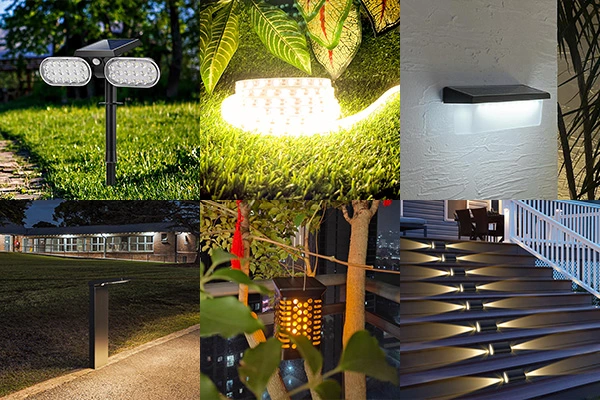
Solar Spot Lights
It is perfect for highlighting specific items in a garden, be they statues, water features, or particularly beautiful plants. In addition to solar spotlights, solar lawn lights are also known. Its two most basic components are the light source and the spike. Its installation is as simple as inserting it directly into the ground and pointing the light source to the area you want to light. These lights focus the beam on its target point, creating a dramatic effect and drawing attention to the chosen area. These lights typically illuminate footpaths, driveways, and garden paths.
Solar Bollard Lights
The lighting properties of the solar column lamp will be greater than those of the solar spot lamp. Its main function is to light trails and sometimes also to kill mosquitoes. It can be installed on lawns. It commonly uses metal materials and can even be installed on hard surfaces, such as parking lots or sidewalks. The accessories in solar lamps are often made from a light source rod or a base with a stake. So installation will be more complicated than a spot light, and it will be more expensive.
Solar Led Strip
The main function of the solar lamp belt is for decoration. Its flexibility is high, and its application scenarios are not limited to shrubs. It can also be used for fences, exterior walls, balconies, and other uses. Solar lamp belts often use a very soft material, such as silicone. Its length on the market ranges from 3m to tens of meters, and different lengths are suitable for different scene needs. Since it is mainly used for decoration, there are also many options for lighting colors.
Solar Hanging Garden Light
Solar hanging garden lights include popular varieties such as solar candle lights and solar flame lights. These lights are designed to be hung from trees, courtyards, or other outdoor structures. These types of lamps are not large and are primarily used to decorate the garden and the surrounding area. These lamps often have different lighting effects, colors, flickering, and other effects. Because the lamp needs sunlight to charge, it must be noted that when installing, ensure that the leaves and branches of the bush do not block the solar panel.
Solar Wall lights
There are two types of solar wall lamps: one that is used for lighting and the other for decoration. Solar wall lamps for lighting are often used with induction heads. The sensor function can achieve a more energy-saving mode, saving electricity consumption. The battery capacity of the lit solar wall lamp will be larger than that of the decorative wall lamp because the lighting needs to be higher in brightness. Decorative solar wall lamps do not require higher brightness, and they only have one aesthetic function. It has options for lighting effects, flicker effects, and lighting colors.
Solar Step Light
Solar step lights are a functional and decorative lighting solution. It is designed for ground lighting, with stairway walls, particularly the stairs. Because they have both lighting and decorative functions, there is a balance between lighting effects and the lighting itself. The solar ladder lamp will be designed in a variety of colors, so there will not be too many effects to choose from. In terms of material quality, stainless steel and plastic are very common, with different budgets and different choices. It ensures safe navigation at night while adding beauty to the surroundings.
YINGHAO provides information on various types of solar garden lights. We have pathway lights, wall lights, decorative lights, spotlights, and more. This can help you choose the ideal lighting solution based on your unique needs and preferences.
Solar panels are important components for solar lamps used to obtain electricity. Solar panels are responsible for converting sunlight into usable electricity. The cost-effectiveness and advantages of solar panels using different materials will vary widely. Next, I will introduce four types of solar panels commonly used in the solar lighting market. These include monocrystalline silicon solar panels, polycrystalline silicon solar panels, thin-film solar panels, and amorphous silicon solar panels.
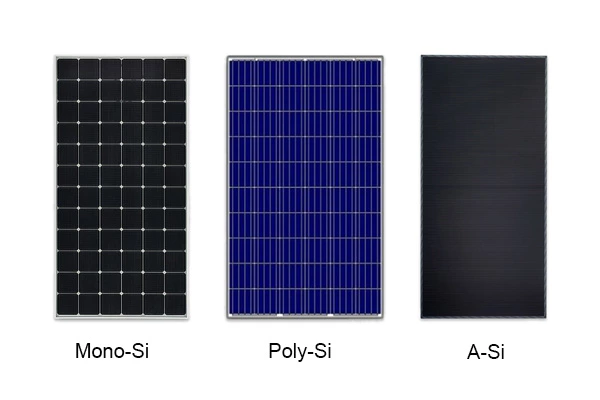
Mono-Si solar panels are currently the solar panel materials with the highest conversion rate that can be commercially mass-produced. Because of their conversion rates, they are more expensive than polysilicon solar panels. Conventional monocrystalline silicon solar panels have a photoelectric conversion rate in the range of 17% to 22%. However, it is slow to charge in low-light environments, so it is not suitable for areas that are cloudy all year. It is typically for solar lights with lighting needs.
The photoelectric conversion efficiency of Poly-Si is slightly lower than that of Mono-Si. The conversion efficiency of polycrystalline silicon solar panels is in the range of 15%–17%. Poly-Si materials have a lower conversion rate than Mono-Si materials, meaning that Poly-Si solar panels need a larger area to achieve the same benefits. The disadvantage of crystalline silicon solar panels is that they charge slowly in low-light environments. It is suitable for all types of solar lamps.
The most direct advantage of thin-film solar panels is that their flexibility, light, and low-light charging efficiency are not affected. They can be made of many different materials. The conversion efficiency of thin-film solar panels is usually in the range of 10%–13%. Although its photoelectric conversion efficiency is low, many manufacturers choose to use it. By combining the light duration of the market with strict cost calculations, it is the best choice for some areas that don’t get much sunlight year-round.
Amorphous silicon solar panels are also suitable for use in countries with weak light conditions. It also charges efficiently in low-light environments. Its photoelectric conversion efficiency is typically in the range of 10%–15%. The disadvantage is that the structure of amorphous silicon is unstable, and the conversion rate will decrease over time, so its life is not very long. The same is used in non-lighting solar lamps, such as decorative lights, stair lights, and so on.
For B2B buyers, the choice of solar panel material should align with the intended use of the light, available space, and budget constraints of the solar panel system. The conversion rates of solar panels described above are for reference only. The conversion rate of specific solar panels is related to the manufacturer's crafting, technology, laminate materials, and other factors. Therefore, when making a choice, we always give priority to the specific needs of the project and the measured data of the product.
The battery will largely determine how long the solar garden lights will work. It stores the energy converted from solar panels, ensuring stable nighttime lighting even in the absence of sunlight. Choosing the right battery can give you the best cost-performance for solar lamps. The most commonly used batteries in solar garden lights are lithium batteries, lithium iron phosphate batteries, and nickel-metal hydride batteries.
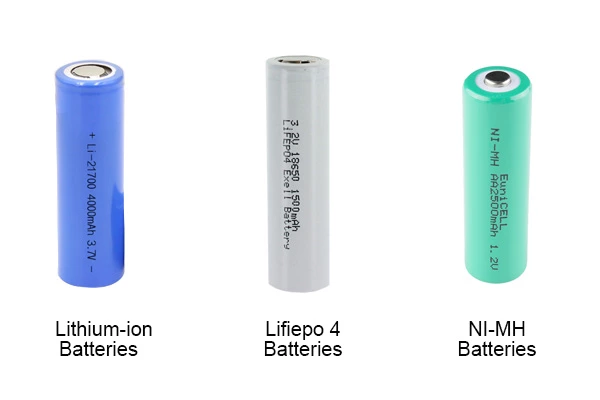
The advantages of lithium batteries are their high energy density and small size, but they will be more expensive. It is suitable for solar garden lights with lighting needs. Generally, decorative solar lights do not use lithium batteries. Its battery life is relatively long, and its low temperature resistance is very good. The lowest operating temperature of lithium batteries can reach -30°C. It is also used in some countries with colder winters, such as Russia, Canada, and so on. Because the material contains rare earth elements, such as cobalt, the battery is more active and requires the installation of a protective plate. The cost will be higher than for other batteries.
The Lifiepo 4 battery is worth mentioning for its cycle life of up to 2000 days, and its life is relatively long. The second advantage is high temperature resistance, which is very safe from fire. In contrast, its low-temperature performance is worse than that of lithium batteries. If your market is Africa or the Middle East, these tropical countries are well suited to your needs. Also, because it contains rare earth elements, it is recommended to install a protective plate. In terms of cost, using the Lifiepo 4 batteries will be cheaper than lithium batteries.
NiMH batteries are the most environmentally friendly batteries; they have no memory effect and last longer than NiMH batteries. However, the comprehensive effect is much greater than that of lithium batteries, and the energy density is relatively low. Of the three batteries, it is the most economical. They are best suited for small decorative solar lamps that do not require a lot of electricity to provide lighting. NiMH batteries are very environmentally friendly and do not contain any active elements, so there is no need to add a protective plate to use in the process.
Battery configuration also needs to be combined with your sales and marketing climate, service life, budget, and other factors to make decisions. The most important thing to consider with solar garden lights is the lighting requirements. Buyers need to calculate the battery capacity of your solar lamp to ensure a few days of lighting. After calculating the battery capacity, you can decide what materials to use based on safety, price, etc.
Now let's take a look at the component beads that make the solar garden lights light up. These tiny illuminators determine the brightness, efficiency, and lifetime of the light. For different buyers, the choice of lamp beads can vary according to specific requirements. In this section, we will explore the three types of lamp beads commonly used in yard lights: pin DIP, SMD, and COB.
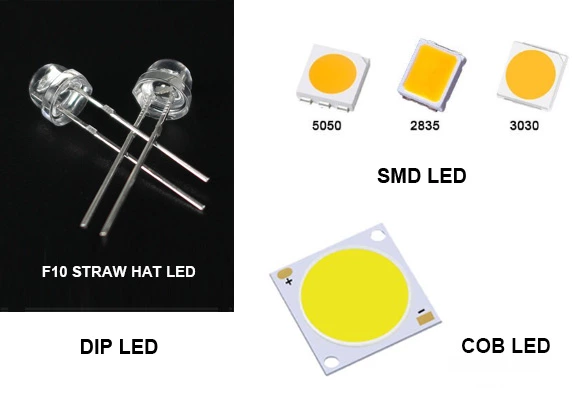
Dual-in-line Package (DIP) LEDs are a chip inside a hard plastic bulbous head with two straight parallel connecting pins. Straw hat lamp beads are a type of DIP LED commonly used in garden lights. Out of all the straw hat lamp beads, the F10 is the most commonly used model. The pin F10 lamp bead is known for its compact size and concentrated light output. Because it has two pins, heat dissipation is relatively poor, and its life is limited. One of the significant advantages of pin F10 beads is their ability to produce a focused beam of light. Its usual luminous efficiency is 80 LM/W, which is suitable for some lamps that do not require high brightness. The F10 lamp bead production technology is a very mature, reliable technology, and the cost is relatively low.
SMD beads are a more modern innovation in the field of garden lighting. The beads are flat, allowing for a more streamlined design. SMD lamp beads can be used in almost all indoor and outdoor lighting. At the same time, the high thermal resistance and guaranteed heat dissipation make it much more efficient than F10 lamp beads. Its lighting efficiency is 120–220 LM/W, making it suitable for wall lamps, lawn lamps, chandeliers, and more. In contrast, the SMD lamp bead prices are more expensive than the F10. Below are some common sizes of SMD lamp beads.
| Specification | Size(mm*mm) | Power(Watt) |
|---|---|---|
| 2835 | 2.8*3.5 | 0.2W / 0.5W |
| 3030 | 3.0*3.0 | 0.5W / 1W |
| 5050 | 5.0*5.0 | 1W-5W |
COB chips have a higher light output density and use fewer components. COB chips can produce large lumens with less energy, at least 120 LM/W. They are directly packaged on the solder pad of the lamp bead on the PCB board, giving more space for heat dissipation. Because multiple chips are packaged at once, the COB light source has a relatively uniform light color, making it easier to control the lighting angle and design the light distribution curve. It's suitable for solar garden lights that have certain requirements for brightness. This includes things like solar induction wall lights, solar floodlights, and so on.
Understanding Lamp Bead Efficiency: It's important to note that not all lamp beads are created equal. The efficiency of a lamp bead is determined by its lumen-to-watt ratio. A higher ratio indicates a higher brightness for less power, leading to longer illumination times and better battery conservation. For all buyers, understanding the characteristics of the lamp beads ensures that they meet the specific needs of the market. Having the right lamp beads can enhance the performance of solar garden lighting. It ultimately ensures energy efficiency and customer satisfaction.
Harnessing solar energy for garden lights promotes sustainability. Another way to improve energy efficiency is to install motion sensors. These sensors enable dynamic brightness adjustments based on nearby movements. When motion is detected, the light brightens to a 100% brightness setting. Without activation, it dims to a soft 90% or lower brightness. You can also save energy by adjusting different brightness modes; this strategy extends the light's operational time. It also cuts energy consumption, making garden lighting both eco-friendly and smart.
The aesthetics of solar garden lights play a pivotal role in their appeal, and understanding that different buyers have varying tastes is crucial. The design isn't just about physical appearance; it encompasses functionality, lighting effects, and cultural preferences. For instance, European customers often gravitate towards designs that echo European retro aesthetics, while American patrons typically favor a more straightforward and elegant look.
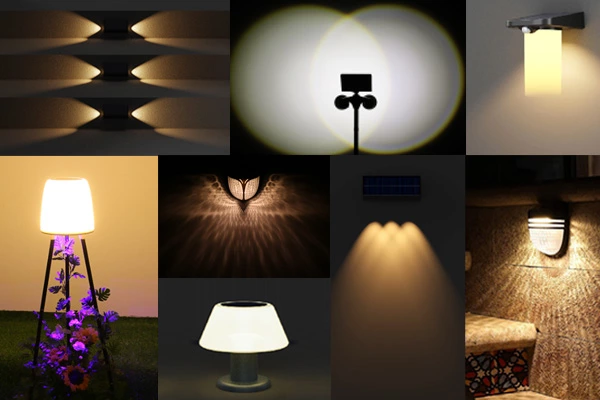
Beyond mere aesthetics, functionality and aesthetics have become deciding factors in people's purchases of solar lights. Decorative lights, especially those meant to accentuate plants, delve deeper into lighting designs than the light itself does. The color of the light, its effects, and the brightness level can dramatically impact the ambiance of a garden.
For the solar garden lights needed for engineering projects, you should work closely with reputable and experienced suppliers. In essence, the world of solar garden light design is vast. It can cater to a myriad of different tastes and functional needs.
Choosing the right supplier for solar garden lights is a decision that goes beyond just the price point. It's about ensuring quality, reliability, and a partnership that stands the test of time. Here are a few dimensions to evaluate potential suppliers:
First impressions often speak volumes. Gauge the supplier's professionalism through their communication, responsiveness, and the way they handle inquiries. The process will be transparent, timely, and customer-centric. An established supplier with years of experience in the industry is likely to have faced and overcome several of these challenges. This will ensure they can handle complex requirements and unforeseen issues.
The solar lighting industry is constantly evolving, with suppliers showing dedication to innovation and keeping up with market trends. This means investing in top-tier technologies that are already in place. Beyond its functionality, the solar garden light design is crucial to its appeal. Suppliers excelling in design provide efficient, attractive products while meeting varied customer tastes. This can be seen through the companies' investment in R&D. This includes how many engineers there are on the R&D team, how much R&D equipment there is, and how many exterior designers there are on the R&D team.
A trustworthy supplier implements strict quality controls. This guarantees that products meet high standards, minimizing defects or performance concerns. When you're communicating with suppliers, you can directly ask "whether there is a product management process." And see whether the quality management standards of the other party use AQL or a higher standard.
Certifications act as a stamp of approval from industry bodies. They verify that suppliers comply with industry standards. These may include manufacturing processes, product quality, or safety standards. Look for suppliers with certifications in ISO 19001, BSCI, or other relevant accreditations. Manufacturers with more experience tend to have more experience.
Selecting a solar garden light supplier is a multifaceted decision. By considering the above factors, buyers can ensure they're partnering with a supplier that aligns with their values, quality standards, and design preferences. Remember, a good supplier relationship is foundational to the success of any project or purchase.
Solar garden lights symbolize more than aesthetics or function; they represent a sustainable future. Let's explore those data-backed benefits.
In 2019, IRENA highlighted solar energy's role in reducing 2.5 gigatonnes of global carbon dioxide emissions from the atmosphere. Solar garden lights contribute to this milestone. More recently, a California community case study revealed a 40% annual energy usage drop after adopting solar garden lights, resulting in lower bills and less grid pressure.
In short, each solar light brightens our planet and heralds a greener future. The statistics confirm its vast environmental impact.
Investing in solar garden lights offers both aesthetic and environmental advantages. From understanding lamp bead types to customizing energy-saving features and designs, buyers have a plethora of choices to choose from. Evaluating suppliers based on professionalism, experience, and quality ensures you get the best results from your suppliers. Remember, YINGHAO stands out for its commitment to green solutions and tailored design practices. Considering bulk purchases? Reach out to YINGHAO today for solar lighting solutions. Please help light up your garden sustainably! Inquire now!
We are available from Monday to Friday
8:30-18:00
YINGHAO
Street: Liande 69
City: Guangdong Province, Zhongshan
ZIP code: 528414
Country: China
This website uses anonymous performance cookies to ensure you get the best experience on our website. We never use targeting or advertising cookies.
Please click here to view our cookie policy.